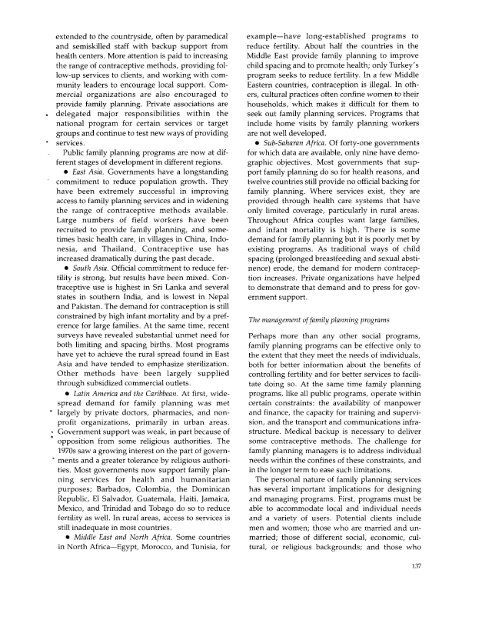World Development Report 1984
World Development Report 1984
World Development Report 1984
You also want an ePaper? Increase the reach of your titles
YUMPU automatically turns print PDFs into web optimized ePapers that Google loves.
extended to the countryside, often by paramedical example-have long-established programs to<br />
and semiskilled staff with backup support from reduce fertility. About half the countries in the<br />
health centers. More attention is paid to increasing Middle East provide family planning to improve<br />
the range of contraceptive methods, providing fol- child spacing and to promote health; only Turkey's<br />
low-up services to clients, and working with com- program seeks to reduce fertility. In a few Middle<br />
munity leaders to encourage local support. Com- Eastern countries, contraception is illegal. In othmercial<br />
organizations are also encouraged to ers, cultural practices often confine women to their<br />
provide family planning. Private associations are households, which makes it difficult for them to<br />
delegated major responsibilities within the seek out family planning services. Programs that<br />
national program for certain services or target include home visits by family planning workers<br />
groups and continue to test new ways of providing are not well developed.<br />
services. * Sub-Saharan Africa. Of forty-one governments<br />
Public family planning programs are now at dif- for which data are available, only nine have demoferent<br />
stages of development in different regions. graphic objectives. Most governments that sup-<br />
* East Asia. Governments have a longstanding port family planning do so for health reasons, and<br />
commitment to reduce population growth. They twelve countries still provide no official backing for<br />
have been extremely successful in improving family planning. Where services exist, they are<br />
access to family planning services and in widening provided through health care systems that have<br />
the range of contraceptive methods available. only limited coverage, particularly in rural areas.<br />
Large numbers of field workers have been Throughout Africa couples want large families,<br />
recruited to provide family planning, and some- and infant mortality is high. There is some<br />
times basic health care, in villages in China, Indo- demand for family planning but it is poorly met by<br />
nesia, and Thailand. Contraceptive use has existing programs. As traditional ways of child<br />
increased dramatically during the past decade. spacing (prolonged breastfeeding and sexual absti-<br />
* South Asia. Official commitment to reduce fer- nence) erode, the demand for modern contraceptility<br />
is strong, but results have been mixed. Con- tion increases. Private organizations have helped<br />
traceptive use is highest in Sri Lanka and several to demonstrate that demand and to press for govstates<br />
in southern India, and is lowest in Nepal ernment support.<br />
and Pakistan. The demand for contraception is still<br />
constrained by high infant mortality and by a pref- The management of family planning programs<br />
erence for large families. At the same time, recent<br />
surveys have revealed substantial unmet need for Perhaps more than any other social programs,<br />
both limiting and spacing births. Most programs family planning programs can be effective only to<br />
have yet to achieve the rural spread found in East the extent that they meet the needs of individuals,<br />
Asia and have tended to emphasize sterilization. both for better information about the benefits of<br />
Other methods have been largely supplied controlling fertility and for better services to facilithrough<br />
subsidized commercial outlets. tate doing so. At the same time family planning<br />
* Latin America and the Caribbean. At first, wide- programs, like all public programs, operate within<br />
spread demand for family planning was met certain constraints: the availability of manpower<br />
largely by private doctors, pharmacies, and non- and finance, the capacity for training and superviprofit<br />
organizations, primarily in urban areas. sion, and the transport and communications infra-<br />
Government support was weak, in part because of structure. Medical backup is necessary to deliver<br />
opposition from some religious authorities. The some contraceptive methods. The challenge for<br />
1970s saw a growing interest on the part of govern- family planning managers is to address individual<br />
ments and a greater tolerance by religious authori- needs within the confines of these constraints, and<br />
ties. Most governments now support family plan- in the longer term to ease such limitations.<br />
ning services for health and humanitarian The personal nature of family planning services<br />
purposes; Barbados, Colombia, the Dominican has several important implications for designing<br />
Republic, El Salvador, Guatemala, Haiti, Jamaica, and managing programs. First, programs must be<br />
Mexico, and Trinidad and Tobago do so to reduce able to accommodate local and individual needs<br />
fertility as well. In rural areas, access to services is and a variety of users. Potential clients include<br />
still inadequate in most countries. men and women; those who are married and un-<br />
* Middle East and North Africa. Some countries married; those of different social, economic, culin<br />
North Africa-Egypt, Morocco, and Tunisia, for tural, or religious backgrounds; and those who<br />
137









